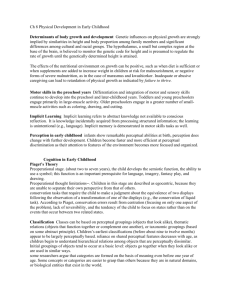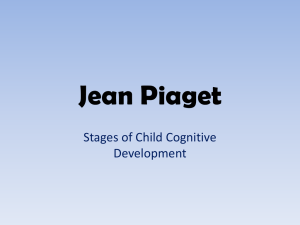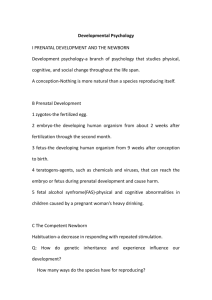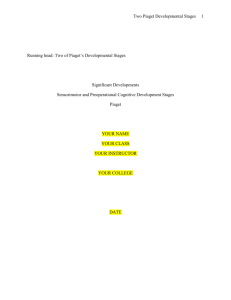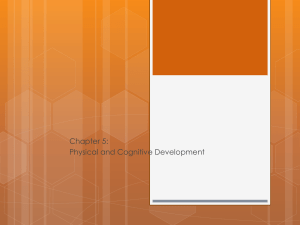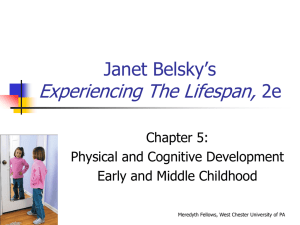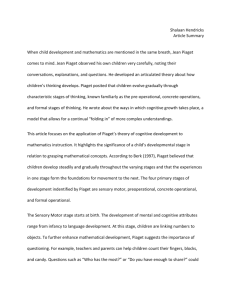Chapter9.doc
advertisement
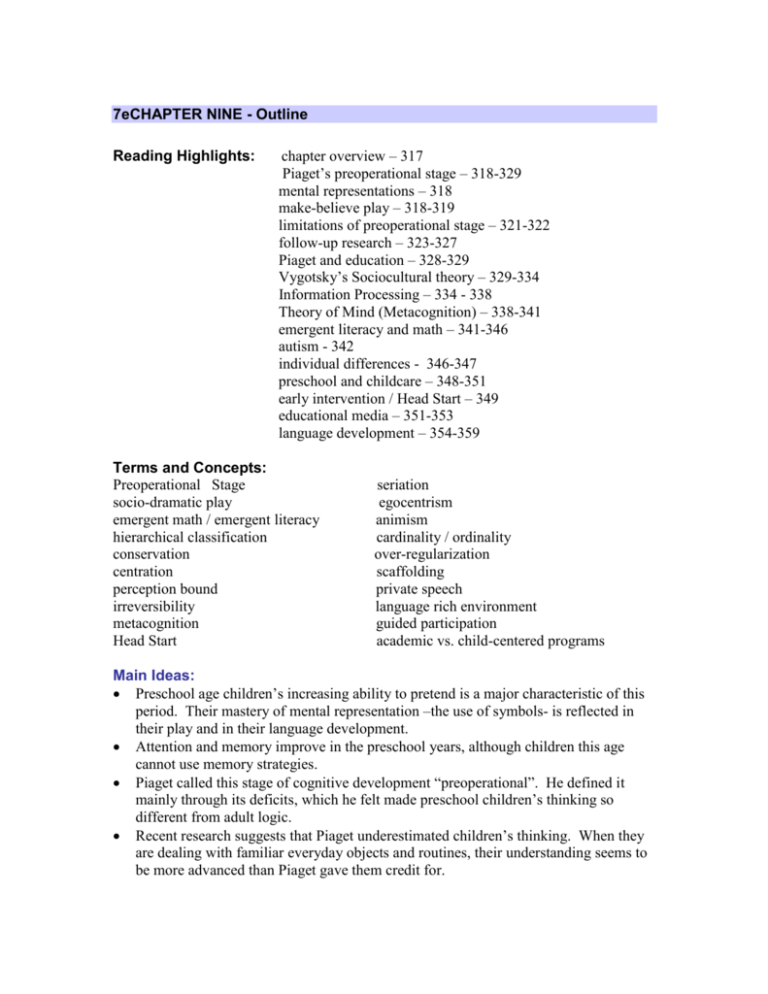
7eCHAPTER NINE - Outline Reading Highlights: chapter overview – 317 Piaget’s preoperational stage – 318-329 mental representations – 318 make-believe play – 318-319 limitations of preoperational stage – 321-322 follow-up research – 323-327 Piaget and education – 328-329 Vygotsky’s Sociocultural theory – 329-334 Information Processing – 334 - 338 Theory of Mind (Metacognition) – 338-341 emergent literacy and math – 341-346 autism - 342 individual differences - 346-347 preschool and childcare – 348-351 early intervention / Head Start – 349 educational media – 351-353 language development – 354-359 Terms and Concepts: Preoperational Stage socio-dramatic play emergent math / emergent literacy hierarchical classification conservation centration perception bound irreversibility metacognition Head Start seriation egocentrism animism cardinality / ordinality over-regularization scaffolding private speech language rich environment guided participation academic vs. child-centered programs Main Ideas: Preschool age children’s increasing ability to pretend is a major characteristic of this period. Their mastery of mental representation –the use of symbols- is reflected in their play and in their language development. Attention and memory improve in the preschool years, although children this age cannot use memory strategies. Piaget called this stage of cognitive development “preoperational”. He defined it mainly through its deficits, which he felt made preschool children’s thinking so different from adult logic. Recent research suggests that Piaget underestimated children’s thinking. When they are dealing with familiar everyday objects and routines, their understanding seems to be more advanced than Piaget gave them credit for. Piaget downplayed the importance of language in cognitive development. Lev Vygotsky, on the other hand, believed language was the basis for all complex mental activity. Vygotsky also emphasized learning within a social context. He noted that children use “private speech” for self-guidance when solving a problem or mastering a skill. Information Processing theory focuses on cognitive processes such as memory, attention and problem solving. Preschoolers begin to be capable of metacognition, or “thinking a bout thought”. Children’s awareness of, and understanding of, reading and writing grow steadily through exposure to print materials. This is the process of emergent literacy. Their mathematical understanding also grows gradually with exposure to numbers and mathematical concepts. What kind of program best supports children’s cognitive development? Piaget’s work has led to a variety of “hands on” exploratory play programs. On the other hand, many programs follow the traditional teacher-directed academic model. So far, research does not show lasting gains from the second approach, and such programs may cause early burnout. High quality preschool early intervention programs like Head Start have been shown to give children from economically disadvantaged backgrounds a good foundation for learning and school success. By preschool age, children can really carry on a conversation. Their vocabularies grow enormously, as does their use of complex grammar. A “language rich environment” (which includes give and take with more skilled speakers) seems to be the most important factor in this development. Berk Chapter 9: Cognitive Development in Early Childhood 6e Piaget’s Theory: the Preoperational Stage The Preoperational stage covers ages ____ to ____. The most important change in cognitive development between children in the Sensorimotor stage and children in the Preoperational stage is the increase in ______________ _______________________. One example of this increased ability to mentally represent the world is the development of ________________, which Piaget called the most flexible means of mental representation. Nevertheless, Piaget did not think it played an important role in cognitive development. What did he believe came before words? ____________________________________________________________ A second example of increased mental representation during the preschool years is the increase in __________-_______________ ____________. Explain 3 ways that play develops during this period: 1.____________________________________________________________________ ______________________________________________________________________ 2._____________________________________________________________________ _______________________________________________________________________ 3.______________________________________________________________________ _______________________________________________________________________ During make-believe play, children know they are pretending – their talk and actions show an awareness that play is a ____________________________ activity. Benefits of Play Many child development experts now believe that Piaget’s view of play was too narrow. Children who spend more time in sociodramatic play are seen as more __________ _________________ by their teachers. Many studies suggest that sociodramatic play also strengthens other abilities – list 5: ____________________________ _____________________________ ____________________________ _____________________________ ____________________________ (Look at the table on page 320 to see how adults can support opportunities for make believe play.) Limitations of Preoperational Thought Piaget noted the major increase in ability in mental representation in the preoperational period, but otherwise he focused mainly on what children _________ ___________ in this period – he said that children in this stage are not capable of mental operations, and that their thinking is rigid, limited and very influenced by appearances. Understanding these characteristics is the key to understanding Piaget’s view of this stage. Here are some characteristics of this stage. Try to define them in your own words: EgocentrismAnimismCentered (Centration)IrreversibleHere are some other cognitive difficulties that Piaget noted in this stage. Children in the preoperational stage fail to conserve – this means that they do not understand that the quantity of a material can remain the same even when the ________________ changes. Read about 4 conservation tasks in figure 9.2. Piaget also noted that preoperational children have difficulty with hierarchical classification – that is to say, they have trouble organizing things into groups and subgroups. See an example of this with the class inclusion flower problem on page 322. Do you remember doing Venn diagrams in school? This is a similar idea. Design a new class inclusion problem using something different from flowers: _______________________________________________________________________ ________________________________________________________________________ New research suggests Piaget’s theory underestimates children’s logical thinking ability. What are 2 reasons that Piaget’s problems might have confused children: __________________________________________________ __________________________________________________ Briefly explain how conversation shows us that preoperational children are not as egocentric as Piaget thought: ________________________________________________________________________ As far as animism is concerned, the text tells us that children actually begin to distinguish between what is animate or inanimate in infancy, but are sometimes confused when things are ___________________ or have _____________________________. Even though preschool aged children do believe in magical beings like fairies, do they believe that magic can change everyday experience? Yes / No Magical beliefs decline between ages ____ and _____, as children come to experience and understand the physical world better. Piaget’s theory has had a huge impact on education. List and briefly explain 3 principles of education that derive from his theory: 1. __________________________________________________________________ 2. _________________________________________________________________ 3.___________________________________________________________________ Young children frequently talk out loud to themselves as they go about their daily business. Piaget called this _____________ ___________. He explained it thus: ____________________________________________________________________. Lev Vygotsky disagreed with Piaget. He believed children talk to themselves because ______________________________________________________________ ____________________________________________________________________. Research supports Vygotsky’s view, so we now call this self-talk _______________ ___________. Unlike Piaget, Vygotsky stressed that children learn from others in a social context. Research says that children learn best from an adult or an “expert” peer. Name and define the 2 features that must exist for social interaction to increase cognitive development: 1.___________________________________________________________________ ___________________________________________________________________ 2. __________________________________________________________________ _____________________________________________________________________ A broader term for scaffolding is guided participation. (Read the box on page 333 for an interesting look at how culture shapes children’s learning about work, and their sense of responsibility.) Information Processing Theory This theory focuses on changes to the mental strategies and mental abilities of children of different stages. When we compare preschoolers to toddlers and infants, we see that preschoolers have improved: A_____________________________ (Why? ______________________________) Pl_____________________________ M_____________________________ As preschoolers language, memory and mental representation abilities improve, they development the ability to think about thinking; this is called ___________________. Give one example of this from preschool. (Select from the examples in the text on pages 339).___________________________________________________________ _____________________________________________________________________ _____________________________________________________________________ Early Literacy and Math Development We now know that children don’t simply learn to read all at once, but rather that literacy (learning to read and write) is an emergent process that starts as early as infancy, and is closely connected to language development. The text says children construct literacy knowledge through informal experiences – name 2 examples of this from play or daily life experiences: 1.___________________________________________________________________ 2.___________________________________________________________________ Look at page 343 and list 3 things that children must learn / understand about literacy in order to become readers: 1.___________________________________________________________________ 2.___________________________________________________________________ 3.___________________________________________________________________ How could good preschool or child care teachers help parents support a child’s literacy development?__________________________________________________ ____________________________________________________________________ ____________________________________________________________________ Emergent Math Mathematical learning is also constructed through informal experiences. Through play and daily life, children begin to grasp important math concepts. Define the following concepts and give an example of each: Ordinality_____________________________________________________________ ______________________________________________________________________ Cardinality _____________________________________________________________ Home Environment and Mental Development List 4 factors affecting intellectual development that might be found in a middle class home but possibly not in an economically disadvantaged home: 1.____________________________________________________________________ 2.____________________________________________________________________ 3._____________________________________________________________________ 4._____________________________________________________________________ Name three possible negative outcomes for children in preschools that stress formal academics: 1.___________________________________________________________________ 2.___________________________________________________________________ 3.___________________________________________________________________ What does the research say about the benefits of preschool intervention? ________________________________________________________________________ ________________________________________________________________________ Briefly explain the estimated cost / benefit ratio for society of investing money in quality early intervention programs:_________________________________________________ ________________________________________________________________________ Language Development Preschoolers learn as many as 5 new words a day! How do they do it? Explain these terms in your own words: Fast mapping _________________________________________________________ ______________________________________________________________________ Syntactic Bootstrapping ______________________________________________________________________ _______________________________________________________________________ Children are also learning grammar. Explain these 2 terms in your own words: Overregularization _______________________________________________________________________ Semantic bootstrapping _______________________________________________________________________ Suggest 3 ways adults support children’s language learning during this period; 1. 2. 3. Practice Quiz #9 1. The teacher is counting the children to go out on the playground, “1, 2…” . As she points to the second child he says indignantly, “I’m not two, I’m three! I’m a big boy!” This is evidence of that his thinking is a. reversible and conserving b. animistic and magical c. egocentric and centered d. static and transformative 2. A teacher in a constructivist classroom (one based on Piaget’s theory of learning) will a. drill children on correct answers b. arrange situations that allow discovery learning c. give children long verbal explanations of concepts d. all of the above 3. Samantha is putting together a puzzle. As she works, she talks to herself thus: “No, that’s big, it goes here. This piece is upside down.” Choose the best statement about her speech: a. Piaget would say she is trying to communicate clearly to someone else in the room. b. she is probably repeating what an adult told her. c. Vygotsky would say that she is guiding herself through the task. d. all of the above 4. New research in regard to Piaget’s theory suggests that a. children’s cognitive development may be more continuous, rather than defined by exclusive stages b. some of Piaget’s questions contained too much new information for preschoolers to handle c. preschoolers’ life experience and culture affects their grasp of concepts d. all of the above 5. Raji and Lyla are playing in the home center. They have dressed all the baby dolls to go to daycare. Raji says “I’m going be so late for my job!” Lyla responds “Here honey, let me take that baby for you.” What is the significance of this play? a. The girls are trying out their ideas about the adult world and about their future roles as women. b. They are stretching their understanding of other people’s points of view as they attempt to speak in the voices of the characters they are playing. c. They are practicing the skill of cooperating in a social setting. d. All of the above 6. Research shows that children whose parents read storybooks to them a. Are delayed in their ability to read for themselves b. Have greater success in school c. Are no different from children whose parents don’t read to them. d. Are entertained, but receive no lasting advantage from it 7. When asked by the teacher how many chairs are in the book circle, Brendan counts them and says “We have six.” He is displaying the mathematical concept of a. cardinality b. reversibility c. ordinality d. ratio 8. Which of the following statements is true about preschools which place a heavy emphasis on academic learning compared to preschools that are child centered? a. Children in child centered preschools demonstrate better social skills b. Academic preschools produce no lasting advantage in academic achievement c. Children who attend academic preschools are more likely to experience school burn-out in the elementary years d. All of the above 9. 4 year old Robbie says, “I runned fast.” This is the result of a. overregularization b. expansion c. ignorance d. poor grammar modeling by adults 10. Your friend is thinking of hiring an expensive magician to entertain at his son’s fourth birthday. Your BEST advice to him is a. to do it because children at that age need entertainment to have fun b. to have elaborate magic tricks, but save money by doing them himself from a book c. to splurge on the magician, because kids of all ages love the challenge of figuring out how magic tricks work d. to save his money and skip the magic, because children of this age find magic tricks no more surprising and wonderful than many real life events Child Growth and Development Video Worksheet (Berk Chapter 9) COGNITIVE DEVELOPMENT – AGE 2 ½ to 6 1. PIAGET’S INFLUENCE– Review of all stages Piaget believed that the ______________ and _____________ of information changes as the child matures and has more experiences – not just what or how much is known The quality and number of _______________ increases 2. THE CHILD IN THE PREOPERATIONAL STAGE Is capable of ___________ _______________________ Does not understand __________ ___________ like __________ and _________ Cannot focus on more than one ________ of a situation Characteristics of this stage: ___________________________________– child perceive events only as she/he is affected by them and believes that everyone else has the same experience ___________________________________– the child has difficulty with thinking that requires reversing a process or the order of things ___________________________________– the child experiences life as a series of separate unrelated events and can’t see the connection between events ___________________________________– is the ability to group objects into categories based on common features such as color, shape, use. The child in this stage has difficulty sorting based on two factors at once. ___________________________________– the process of arranging objects according to quantitative or qualitative differences of some factor. The child at this stage can construct a small series. ___________________________________– the understanding that the quantity of an item remains the same even if appearance is changed. Preoperational children do not understand this - they “fail to conserve”. ___________________________________ – children in this stage have difficulty separating fact from fantasy. TV programs, cartoons and dreams may seem real. They may develop fears of scary monsters. They may believe that saying something makes it true. ___________________________________– children in this stage may believe that inanimate objects think and have a will of their own ____________________________________– children in this stage value routine and ritual. They may believe that the ritual ensures a desired outcome (Example: “I have to put my teddy on this side of the pillow, and my bunny on that side of the pillow so I won’t have bad dreams.”) 3. LANGUAGE DEVELOPMENT There is a major explosion of language between ages __ and __ Children learn new v_________________ and rules of g_____________. They spend years mastering the conjugation of verbs. There is a major connection between language and _____________. At all ages children can ________________more than they can ____________. In preschool years, children learn that language can be used to discuss events and feelings. They become conversationalists. Some developmentally normal stuttering may occur, because ________________ __________________________________________________________________ Children in bilingual homes can master both languages by age three. The most important thing for language development is for the child to have frequent contact with warm caring adults who model good language and talk at a level and pace the child can understand Child Growth and Development Video Worksheet (Berk Chapter 9) COGNITIVE DEVELOPMENT – AGE 2 ½ to 6 1. PIAGET’S INFLUENCE– Review of all stages Piaget believed that the understanding and organization of information changes as the child matures and has more experiences – not just what or how much is known The quality and number of __schemata_____________ increases 2. THE CHILD IN THE PREOPERATIONAL STAGE Is capable of __mental_________ __representation Does not understand _logical_relationships like _cause and _effect Cannot focus on more than one _aspect_ of a situation Characteristics of this stage: _egocentrism____________________– child perceive events only as she/he is affected by them and believes that everyone else has the same experience __irreversibility / lacks reversibility___________– the child has difficulty with thinking that requires reversing a process or the order of things ___static thought_________________________– the child experiences life as a series of separate unrelated events and can’t see the connection between events ___classification________________________________– is the ability to group objects into categories based on common features such as color, shape, use. The child in this stage has difficulty sorting based on two factors at once. ____seriation_______________________________– the process of arranging objects according to quantitative or qualitative differences of some factor. The child at this stage can construct a small series. ___conservation________________________________– the understanding that the quantity of an item remains the same even if appearance is changed. Preoperational children do not understand this - they “fail to conserve”. ___magical thinking________________________________ – children in this stage have difficulty separating fact from fantasy. TV programs, cartoons and dreams may seem real. They may develop fears of scary monsters. They may believe that saying something makes it true. ___animism________________________________– children in this stage may believe that inanimate objects think and have a will of their own ___ritualistic thinking_________________________________– children in this stage value routine and ritual. They may believe that the ritual ensures a desired outcome (Example: “I have to put my teddy on this side of the pillow, and my bunny on that side of the pillow so I won’t have bad dreams.”) 3. LANGUAGE DEVELOPMENT There is a major explosion of language between ages 2 and _6_ Children learn new vocabulary and rules of grammar. They spend years mastering the conjugation of verbs. There is a major connection between language and thinking. At all ages children can take in more than they can express. In preschool years, children learn that language can be used to discuss events and feelings. They become conversationalists. Some developmentally normal stuttering may occur, because thoughts come faster than they can be expressed. Children in bilingual homes can master both languages by age three. The most important thing for language development is for the child to have frequent contact with warm caring adults who model good language and talk at a level and pace the child can understand


